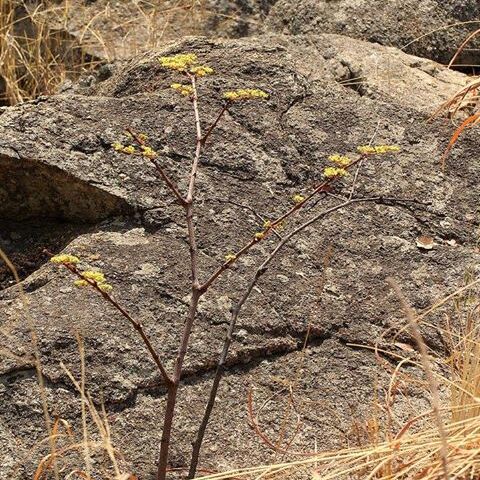A shrub up to 2 m high. The shoots are stout and rusty coloured. The nodes are swollen. The shoots arise from a woody base. It can be a scrambler. The leaves are simple and oval and 6 cm long. There are teeth along the edge. The leaves have red hairs underneath. The flowers are small and yellow. They are in stalked clusters and appear before the leaves. The clusters are 2-10 cm across. The fruit are oval and 10 mm long. They are purple black. They are juicy when ripe and contain one seed. The fruit occur in large clusters.
Leaves simple, appearing after the flowers; petiole 2–7 mm. long; leaf-lamina up to 7·8 × 5 cm., narrowly elliptic to elliptic, acute to obtuse at the apex, dentate at the margin, cuneate, rounded or occasionally cordate at the base; stipules 2–5 × 2–3 mm., oblong to triangular, caducous.
Erect or sometimes semiscandent shrub; stern and branches cylindric; young shoots often ferruginous-tomentose becoming glabrescent when adult, but sometimes almost glabrous; tendrils occasionally present.
Cymes leaf-opposed; peduncle 4–9 cm. long, pubescent to glabrescent; pedicels 2 mm. long, lengthening to 5 mm. in fruit, glabrous; bracts and bracteoles up to 2 mm. long, pubescent to glabrous.
Erect plant, occasionally with tendrils. Young shoots often ferruginous-tomentose, becoming glabrescent when adult. Leaves simple, narrowly elliptic to elliptic. Flowers yellow.
A savannah plant with a woody base sending up erect or suberect shoots each year after the fires
Flowers greenish-yellow, appearing first on leafless shoots
Ovary glabrous; style 0·5 mm. long; stigma subcapitate.
Seed 1, 9 × 5 mm., smooth with dorsal crest.
Fruit purple-black, 10 × 8 mm., ovoid.
Calyx 1 mm. long, subentire, glabrous.
Flower-bud 2 mm. long, glabrous.
Fruits black-purple.

